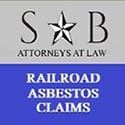
Many retired railroad workers are unaware that they may be eligible for asbestos-related compensation, even years or decades after leaving the workforce. Asbestos exposure, often from insulation, brake pads, and other materials, has left countless railroad workers at risk for diseases like mesothelioma, lung cancer, and asbestosis. Fortunately, there are ways for retired railroad workers to seek compensation without the stress, time, and cost associated with court proceedings.
This article will explore how retired railroad workers can file asbestos claims outside of court, the benefits of working with asbestos trust funds, and the value of experienced legal guidance.
Understanding Asbestos Exposure in the Railroad Industry
For much of the 20th century, asbestos was a mainstay material used in high-temperature settings, making it popular in railroads where heat resistance was essential. Railroad workers, especially those who worked before the 1980s, were routinely exposed to asbestos in various forms, such as:
- Locomotive Insulation: Asbestos was used in steam engine boilers, pipes, and other engine parts as insulation material.
- Brake Pads and Clutches: Asbestos-containing brake pads and clutches released harmful asbestos fibers during regular maintenance or replacement.
- Gaskets and Sealants: These asbestos products were used in locomotive machinery and on train lines due to their durability and heat resistance.
Unfortunately, inhaled asbestos fibers can lodge in the lung tissue, leading to chronic respiratory diseases and even certain cancers, often decades after the initial exposure.
Why Retired Railroad Workers May Not Need Court for Compensation
For retired railroad workers with asbestos-related illnesses, pursuing a claim does not necessarily mean going to court. Asbestos trust funds offer an alternative method to file for compensation. In the late 20th century, many companies involved in asbestos manufacturing and distribution filed for bankruptcy to manage the overwhelming number of lawsuits filed by asbestos victims. As part of these bankruptcy proceedings, these companies were required to establish asbestos trust funds to ensure future claimants could still receive compensation.
Retired railroad workers with asbestos-related diseases can file claims with these trusts, which are designed to streamline the compensation process. The process is usually administrative and typically does not require going to court. Each trust has its own claim filing requirements, and approval is generally based on a thorough review of employment history, medical records, and exposure details.
The Role of Asbestos Trust Funds
Asbestos trust funds were created specifically to compensate victims of asbestos exposure. With over $30 billion set aside across various trust funds, there is significant financial support available for those who qualify. Retired railroad workers can file claims with these trusts if they meet certain eligibility criteria, which typically include:
- Proof of Asbestos-Related Illness: Medical documentation demonstrating a diagnosis of an asbestos-related disease, such as mesothelioma, asbestosis, or asbestos-induced lung cancer.
- Employment and Exposure History: Records showing the claimant worked in the railroad industry or other qualifying roles where asbestos exposure was likely.
- Demonstrated Link Between Exposure and Diagnosis: Expert reviews or documentation linking the claimant’s condition to occupational asbestos exposure, especially if linked to known asbestos products or materials used in railroads.
With these trusts, retired railroad workers avoid the lengthy litigation process, and compensation can often be obtained more quickly. It’s essential, however, to navigate the claim requirements accurately to ensure a claim is approved and compensated fairly.
Steps to Filing an Asbestos Claim Without Going to Court
For retired railroad workers pursuing an asbestos claim through trust funds, the steps are generally straightforward. While the process can be handled without appearing in court, it requires precise documentation and eligibility verification. Here are the main steps:
- Gathering Medical Records and Diagnosis Documentation: Medical records showing the diagnosis of an asbestos-related disease are essential. Doctors’ reports, pathology results, and other medical documentation provide the foundation of the claim.
- Collecting Employment Records: Employment history showing work in the railroad industry, especially in positions or locations known for asbestos use, is critical. These records help establish the link between occupational exposure and the diagnosed condition.
- Identifying Specific Asbestos Trusts: Since multiple trusts may exist for different asbestos-manufacturing companies, it’s essential to identify the trusts most likely to cover a retired worker’s exposure. This step often requires specialized knowledge to ensure no potential compensation source is overlooked.
- Filing the Claim: Once the necessary documentation is in place, the claim can be submitted directly to the asbestos trust. A claims administrator will review the case to determine eligibility and the compensation amount.
- Approval and Payment: If the claim is approved, the trust fund will issue a payment, often in the form of a lump sum or scheduled payout, depending on the trust’s policies and the severity of the illness.
The trust claim process is typically streamlined and requires only administrative approvals rather than courtroom proceedings. However, working with an experienced asbestos claims attorney can help ensure accuracy in documentation and maximize compensation.
Benefits of Filing an Asbestos Claim Outside of Court
Filing an asbestos claim with a trust fund, rather than pursuing a lawsuit, offers several benefits to retired railroad workers:
- Efficiency: Trust claims are generally processed faster than lawsuits, allowing claimants to receive compensation more quickly.
- Reduced Stress: The claims process is administrative and does not require going to court, which minimizes stress and allows claimants to focus on their health.
- Lower Legal Costs: Since trust claims don’t require litigation, the costs are generally lower, and many attorneys handle these claims on a contingency basis, meaning they only get paid if the claim is successful.
- Guaranteed Funds: Asbestos trust funds are set aside explicitly for victims, meaning there is a high likelihood of payout if the claim is approved, provided funds are still available.
How Sammons & Berry, P.C. Can Help Retired Railroad Workers
Sammons & Berry, P.C. specializes in helping retired railroad workers file asbestos claims without going to court. Their team has deep knowledge of the specific requirements of asbestos trust funds, including identifying relevant trusts, gathering necessary documentation, and handling claim submissions. With extensive experience in asbestos law, Sammons & Berry can streamline the process and maximize the chances of approval, even for claims submitted years after retirement.
Sammons & Berry offers free consultations to help potential claimants understand their eligibility and guide them through the process. With compassion and expertise, their attorneys ensure that retired railroad workers and their families receive the compensation they deserve.
Alternatives to Asbestos Trust Funds for Railroad Workers
While trust funds are a primary source of compensation, some retired railroad workers may have additional avenues for filing claims outside of court. Other options may include:
- Federal Employers Liability Act (FELA) Claims: The Federal Employers Liability Act provides compensation for railroad workers injured due to employer negligence. Retired workers diagnosed with an asbestos-related condition due to unsafe working conditions may qualify for compensation under FELA.
- Workers’ Compensation Claims: Some states allow retired workers with occupational illnesses to file workers’ compensation claims, though benefits can vary significantly.
- Veterans’ Benefits: Railroad workers who served in the military may also qualify for veterans’ benefits if they were exposed to asbestos during service.
Consulting with an experienced attorney helps determine eligibility for these alternative compensation options, ensuring all potential sources are explored.
Frequently Asked Questions about Asbestos Claims Without Court
Q1. Is filing a claim with an asbestos trust fund the same as suing? No. Filing a claim with an asbestos trust fund is an administrative process and does not involve litigation. The trust fund reviews the claim and awards compensation if eligibility criteria are met.
Q2. How long does the trust fund claim process take? The timeframe can vary, but many trust fund claims are processed within several months. Some trusts offer expedited reviews for cases with a clear diagnosis and well-documented exposure history.
Q3. Can I file claims with more than one trust? Yes. Depending on the worker’s exposure history and the asbestos products they encountered, multiple trusts may be applicable, allowing the claimant to maximize their compensation.
Q4. Do I need a lawyer to file a trust fund claim? While it’s not mandatory, having an experienced lawyer can help streamline the process, ensure thorough documentation, and improve the likelihood of approval and fair compensation.
Take Action: Secure Compensation Without Court
For retired railroad workers dealing with asbestos-related health issues, accessing compensation doesn’t have to mean going to court. With over $30 billion in asbestos trust funds available, retired workers have a powerful resource to help manage medical costs and provide financial support. Sammons & Berry, P.C. is here to guide you through each step of the claim process, ensuring that you can seek the compensation you’re entitled to without the burden of court proceedings. Contact their experienced team today for a free consultation to learn how they can help.
See if you qualify for compensation
Sammons & Berry, P.C.
800-519-1440
View our Google Listing
View our Facebook


